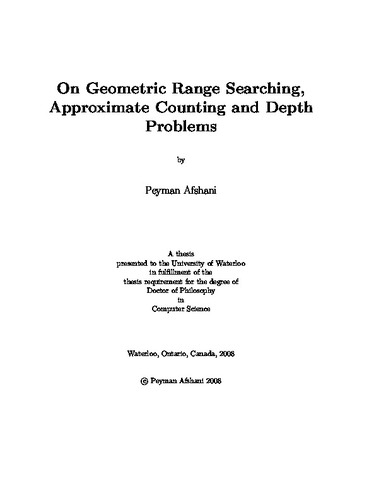| dc.description.abstract | In this thesis we deal with problems connected to range searching,
which is one of the central areas of computational geometry.
The dominant problems in this area are
halfspace range searching, simplex range searching and orthogonal range searching and
research into these problems has spanned decades.
For many range searching problems, the best possible
data structures cannot offer fast (i.e., polylogarithmic) query
times if we limit ourselves to near linear storage.
Even worse, it is conjectured (and proved in some cases)
that only very small improvements to these might be possible.
This inefficiency has encouraged many researchers to seek alternatives through approximations.
In this thesis we continue this line of research and focus on
relative approximation of range counting problems.
One important problem where it is possible to achieve significant speedup
through approximation is halfspace range counting in 3D.
Here we continue the previous research done
and obtain the first optimal data structure for approximate halfspace range counting in 3D.
Our data structure has the slight advantage of being Las Vegas (the result is always correct) in contrast
to the previous methods that were Monte Carlo (the correctness holds with high probability).
Another series of problems where approximation can provide us with
substantial speedup comes from robust statistics.
We recognize three problems here:
approximate Tukey depth, regression depth and simplicial depth queries.
In 2D, we obtain an optimal data structure capable of approximating
the regression depth of a query hyperplane.
We also offer a linear space data structure which can answer approximate
Tukey depth queries efficiently in 3D.
These data structures are obtained by applying our ideas for the
approximate halfspace counting problem.
Approximating the simplicial depth turns out to be much more
difficult, however.
Computing the simplicial depth of a given point is more computationally
challenging than most other definitions of data depth.
In 2D we obtain the first data structure which uses near linear space
and can answer approximate simplicial depth queries in polylogarithmic time.
As applications of this result, we provide two non-trivial methods to
approximate the simplicial depth of a given point in higher dimension.
Along the way, we establish a tight combinatorial relationship between
the Tukey depth of any given point and its simplicial depth.
Another problem investigated in this thesis is the dominance reporting problem,
an important special case of orthogonal range reporting.
In three dimensions, we solve this
problem in the pointer machine model and the external memory model
by offering the first optimal data structures in these models of computation.
Also, in the RAM model and for points from
an integer grid we reduce the space complexity of the fastest
known data structure to optimal.
Using known techniques in the literature, we can use our
results to obtain solutions for the orthogonal range searching problem as well.
The query complexity offered by our orthogonal range reporting data structures
match the most efficient query complexities
known in the literature but our space bounds are lower than the previous methods in the external
memory model and RAM model where the input is a subset of an integer grid.
The results also yield improved orthogonal range searching in
higher dimensions (which shows the significance
of the dominance reporting problem).
Intersection searching is a generalization of range searching where
we deal with more complicated geometric objects instead of points.
We investigate the rectilinear disjoint polygon counting problem
which is a specialized intersection counting problem.
We provide a linear-size data structure capable of counting
the number of disjoint rectilinear polygons
intersecting any rectilinear polygon of constant size.
The query time (as well as some other properties of our data structure) resembles
the classical simplex range searching data structures. | en |

